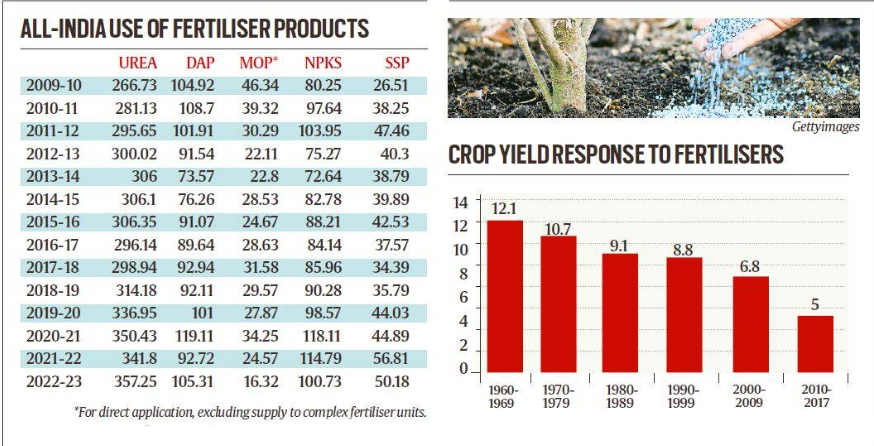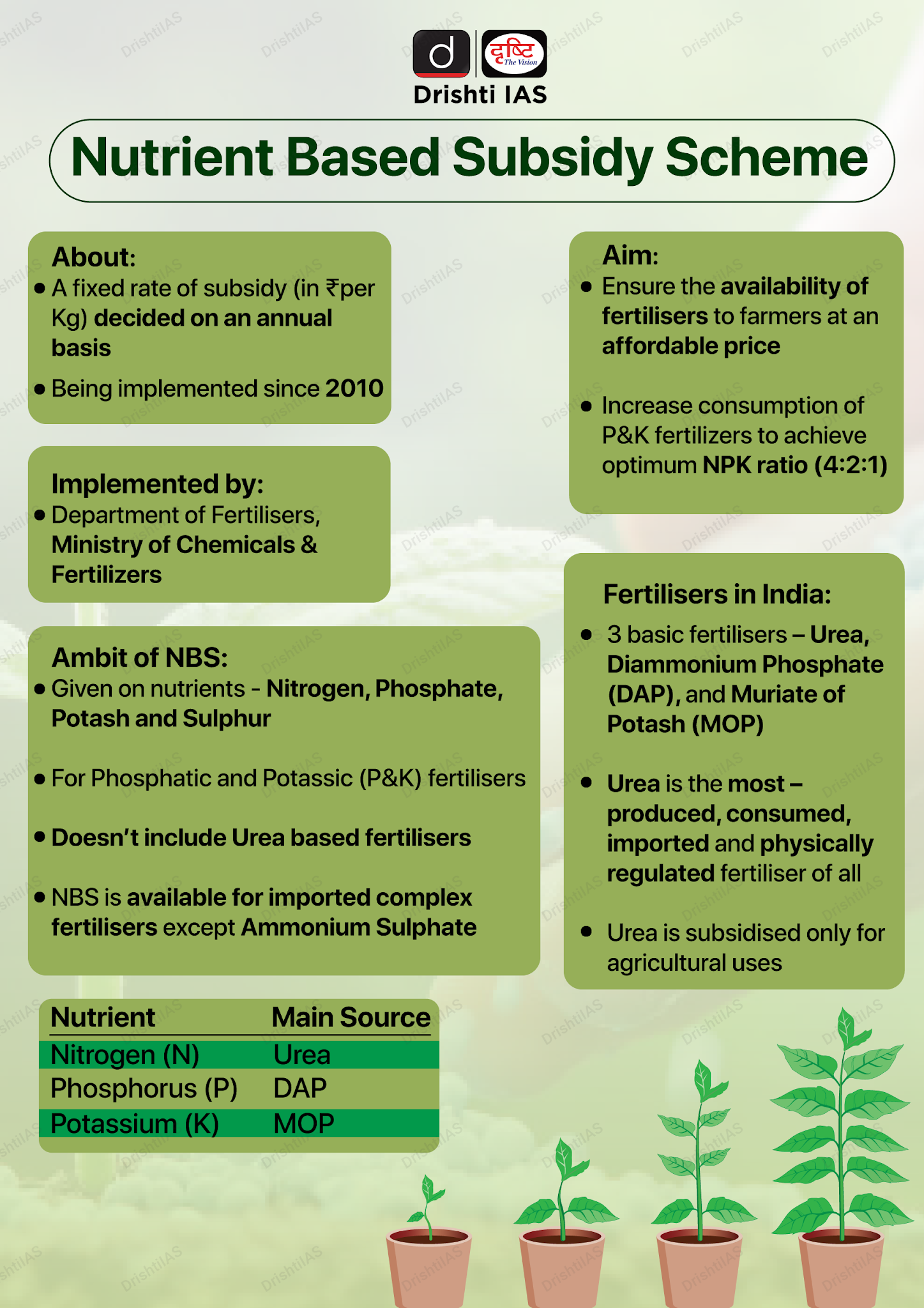Agriculture
Fertiliser Consumption in India
- 26 Apr 2023
- 10 min read
For Prelims: Fertiliser Subsidy, Urea, DAP, Nutrient Based Subsidy (NBS) Scheme
For Mains: Issues Related with Fertiliser Subsidy.
Why in News?
The Indian government has implemented several measures to promote balanced fertilisation. Despite these efforts, the consumption of urea has risen, leading to imbalanced fertilisation, decreased nitrogen use efficiency, and a decline in crop yield response to fertiliser use.
What Measures have been taken to Promote Balanced Fertilisation?
- Initiatives:
- In 2015, Indian government mandated neem-coating of all urea
- Govt introduced 45kg urea bags in place of 50kg to cut demand in 2018
- Indian Farmers Fertiliser Cooperative Limited (IFFCO) launched liquid 'Nano Urea' in 2021.
- More recently, first Liquid Nano Urea (LNU) plant was inaugurated at Kalol, Gujarat.
- LNU is urea in the form of a nanoparticle and is developed to replace conventional urea and curtail its requirement by at least 50%.
- More recently, first Liquid Nano Urea (LNU) plant was inaugurated at Kalol, Gujarat.
- Impact of the Measures Taken:
- Initially, the use of neem-coated urea led to a dip in consumption, making it difficult for urea to be used for non-agricultural purposes.
- However, this trend reversed from 2018-19. Urea sales in 2022-23 were about 5.1 mt higher than in 2015-16 and over 9 mt higher than in 2009-10, before the introduction of the Nutrient-Based Subsidy (NBS) regime in April 2010.
Why does Urea Continue to be the Dominant Fertiliser?
- Favourable Characteristics: Urea is the most widely used fertilizer because it is a rich source of nitrogen, an essential nutrient for plant growth.
- Urea is a readily available and affordable nitrogen source for farmers, making it a popular choice.
- It can also be easily stored and transported, making it a convenient choice for both farmers and manufacturers.
- Urea is also a versatile fertilizer that can be applied to a wide range of crops and soil types.
- Heavy Subsidy: In India, urea is the most produced, imported, consumed and physically regulated fertiliser of all.
- Urea consumption rose by over a third since 2009-10; this has been largely courtesy of its MRP going up by a mere 16.5% – from Rs 4,830 to Rs 5,628 per tonne.
- This current per-tonne MRP for urea against DAP (Rs 27,000) and MOP (Rs 34,000) is nowhere compatible with a 4:2:1 NPK use ratio generally considered ideal for Indian soils.
What is the Nutrient-based Subsidy (NBS) regime?
- Targeted Beneficiaries:
- The NBS regime is aimed at benefiting farmers across the country, especially small and marginal farmers who may not be able to afford fertilizers at market rates.
- The scheme provides subsidies to farmers based on their fertilizer requirements, and the subsidy amount is directly transferred to their bank accounts.
- Benefits:
- It helps in improving soil fertility and crop productivity.
- Reduces the cost of cultivation for farmers by providing fertilizers at subsidized rates.
- Improves the quality of agricultural produce, which can help farmers get better prices for their crops in the market.
- It helps in conserving soil health and reducing the environmental impact of excessive use of fertilizers.
- Failure of NBS:
- Urea is left out of the scheme and hence it remains under price control. There is technically no price control on other fertilizers.
- The prices of the other fertilizers which were decontrolled have gone up which has led the farmers to use more urea than before.
- This has further worsened fertilizer imbalance.
- Price controls on DAP have been reintroduced, with companies not allowed to charge more than Rs 27,000 per tonne. This has led to the sales of both urea and DAP soaring in 2022-23.
- Urea is left out of the scheme and hence it remains under price control. There is technically no price control on other fertilizers.
What is the Cost of Imbalanced Fertilisation?
- Reduced Crop Yields and Quality:
- Applying too little or too much fertilizer can lead to reduced crop yields and quality, resulting in financial losses for farmers.
- Soil Degradation:
- Imbalanced fertilization can lead to nutrient imbalances in the soil, leading to soil degradation, erosion, and loss of soil fertility over time.
- Environmental Pollution:
- Overuse of fertilizers can lead to the leaching of excess nutrients, such as nitrogen and phosphorus, into water bodies, causing eutrophication, algal blooms, and other environmental problems.
- Health Risks:
- Excessive use of fertilizers can result in the accumulation of nitrates in crops, which can be harmful to human health if consumed in large quantities.

Way Forward
- Expand the NBS Regime to Include Urea:
- The current exclusion of urea from the NBS regime has led to an increase in its consumption, exacerbating the problem of imbalanced fertilisation.
- Including urea in the NBS regime would promote its balanced use and reduce its consumption, which would in turn reduce the cost of cultivation for farmers and improve crop productivity.
- The current exclusion of urea from the NBS regime has led to an increase in its consumption, exacerbating the problem of imbalanced fertilisation.
- Encourage the use of Alternative Fertilisers:
- The use of alternative fertilisers, such as organic and bio-fertilisers, can help reduce the reliance on synthetic fertilisers, which can lead to imbalanced fertilisation.
- Promoting the use of alternative fertilisers through subsidies, awareness campaigns, and capacity building can help improve soil health and reduce environmental pollution.
- Promote Soil Testing and Balanced Fertilisation:
- Soil testing can help determine the nutrient requirements of crops, which can help farmers apply fertilisers in a balanced manner.
- Promoting soil testing and providing subsidies for it can encourage farmers to adopt balanced fertilisation practices, which can improve crop yields and soil health.
- Monitor and Regulate the Prices of Decontrolled Fertilisers:
- Regulating the prices of decontrolled fertilisers, such as DAP, can help prevent their excessive use and promote the use of balanced fertilisers.
- The government can consider reintroducing price controls on decontrolled fertilisers to ensure their affordability and prevent their excessive use.
- R&D of Sustainable Fertilisers:
- Investing in R&D of sustainable fertilisers can help develop fertilisers that are environmentally friendly, promote balanced fertilisation, and improve crop productivity.
- The government shall provide funding for R&D of sustainable fertilisers besides encouraging private sector participation.
- Improving NUE (Nitrogen Use Efficiency):
- NUE refers to the proportion of Nitrogen applied mainly through urea that is actually utilized by crops to produce harvested yields.
- It will enable farmers to harvest the same or more grain yields with fewer bags.
UPSC Civil Services Examination, Previous Year’s Question (PYQs)
Q. With reference to chemical fertilizers in India, consider the following statements: (2020)
- At present, the retail price of chemical fertilizers is market-driven and not administered by the Government.
- Ammonia, which is an input of urea, is produced from natural gas.
- Sulphur, which is a raw material for phosphoric acid fertilizer, is a by-product of oil refineries.
Which of the statements given above is/are correct?
(a) 1 only
(b) 2 and 3 only
(c) 2 only
(d) 1, 2 and 3
Ans: (b)
Q. Why does the Government of India promote the use of ‘Neem-coated Urea’ in agriculture? (2016)
(a) Release of Neem oil in the soil increases nitrogen fixation by the soil microorganisms.
(b) Neem coating slows down the rate of dissolution of urea in the soil.
(c) Nitrous oxide, which is a greenhouse gas, is not at all released into atmosphere by crop fields.
(d) It is a combination of a weedicide and a fertilizer for particular crops.
Ans: (b)





